A Brief History of NuTone Intercom Systems
 Thursday, August 9, 2012 at 10:42AM
Thursday, August 9, 2012 at 10:42AM Part 1
In order to understand NuTone intercom system designs you need to understand how the systems fit onto a time line. NuTone system designs were evolutionary, meaning that new models were based on the previous models, but with new features and better technology.
NuTone would design a “platform”, which was the fundamental building block that every model would use. By adding features to the platform, new and different models would be created.
NuTone intercom systems can be divided into different groups based on the type of wire each platform uses. There are two main wire types: 3-wire systems and 6-wire systems. These two wire types comprise about 80% of all NuTone intercom systems.
There are a few exceptions with regard to wire types. NuTone has also made 5-wire, 8-wire and 4-wire systems.
Another design consideration with NuTone intercoms systems is how the wiring is laid out and installed. There are two types of wiring schemes that are used with NuTone intercom systems. They are Home-Run systems and Loop-Wired systems.
Home-Run Systems: In a home-run wiring layout each remote station (entry door, inside and patio) has its own individual cable with the appropriate numbers of wires in the cable (3,4, 5, 6 or 8 wires) and these cables all run directly back to the master station. As an example, if there are 9 remote stations, there will be 9 cables behind the master station. Home-run systems comprise 80% of all NuTone systems.
Loop-Wire Systems: In a looped-wired system, there will be multiple stations on a single cable of wires. As an example, if there are 9 remote stations, these may be grouped onto 3 cables. Cable #1 may have 3 stations, cable #2 may have 4 stations and Cable #3 may have just 2 stations. Behind the master station you will only find the 3 cables. NuTone loop-wired systems use either 6 or 8 wire cable.
One thing to keep in mind is the following rule: NuTone intercom models that were designed to be Looped-Wired systems can be looped-wired or home-run, either layout or a combination of both will work. NuTone intercom models that were designed to be Home-Run systems can only be installed with Home-run wiring, no exceptions.
All of the original NuTone intercom systems were vacuum tube designs, and all vacuum tube models are 3-wire systems with one exception (model 2400, which is a 5-wire, home-run Stereo Music Intercom System).
The first model to use solid-state electronics (transistors and diodes) also used a different wire type. It was the model N2561-2562. This revolutionary model was a huge design step forward for NuTone and was an 8-wire, loop-wired system. The N2561-2562 was in production from 1957 through 1974, that's 17 years!
A quick note about early NuTone model numbers: In the early days, NuTone used model numbers like 2011-2012. The 2011 and 2012 are basically the model except the finish (color) of the model was different. For example, the 2011 had a silver faceplate and the 2012 had a copper-tone faceplate. This is the way NuTone labeled their Intercom models until the mid 1970's. After 1974, NuTone added letters to the model number to denote the finish of the intercom. For example a IMA303T (traditional) was a dark walnut finish, and an IMA303L (light) had a light maple finish.
The last year of production for vacuum tube models was 1966. Since then all models have solid-state electronics.
Vacuum Tube 3-Wire Models:
1954 – 1966: 2011/2012 2013/2014 2015/2016 2053/2054 2055/2056 2057/2058
Vacuum Tube 5-Wire Model:
1957 - 1962: 2400 Stereo Music Intercom
Solid-State 3-Wire Models:
1966 – 1971: 2067/2068
1968 – 1975: 2090/2091 2063/2064
1975 – 1983: IM203/IMA203 IM303/IMA303 IM323/IMA323 IM313/IMA313 + B,C,D
1984 – 1994: IM2003 IM3003/IMA3303 IM3103/IMA3103
1994 – 2006: IM3303/IMA3303
Solid-State 5-Wire Model:
1966 – 1972: 2071 Stereo Music Intercom
Solid-State 8-Wire Model:
1957 – 1974: N2561/N2562 2500
1975 – 1983: I600 SM428
Solid-State 6-Wire Models:
1965 – 1975: 470
1968 – 1975: 2540/2541 2542 462
1975 – 1985: IM406/IMA406 IM806/IMA806
1986 – 1995: IM4006/IMA4006 IM5006
1996 – 2006: IM4404/IMA4406 IM5000
Solid-State 4-Wire Models:
1997 – 2004: IM3204/IMA3204 SR9000 Stereo Music System
Finally we have to include the rarest NuTone Intercom model ever made, the IM6106. Originally the IM6106 was scheduled to be released in 1988 but due to design and manufacturing problems, the release was delayed many times. There were about 400 pre-production units released to dealers and installed in homes. For the next 3 years, everyone struggled to keep these units working until finally the model was dropped and all of the 400 units were replaced at NuTone's expense. If you have an IM6106 you have a rare and unrepairable unit.
 Cindy & Christopher
Cindy & Christopher
Platforms are the starting point:
The very first NuTone intercom systems (the vacuum tube models) were all designed around the same platform and all of these models used the same inside remote, entry door and patio stations. The original idea was that a homeowner would buy a basic model like a 2011 (which only had AM radio) and they could update just the master station to a better model (AM and FM) a few years later.
Of course, this never really happened and the homeowner had to live with just AM radio.
The concept of platforms is still used today. The advantage of using platforms is that it keeps design time and manufacturing costs lower. The disadvantage is that when a new platform is designed it will not be backwards compatible with older models. This means that when a system is updated to a new platform, all of the equipment must be replaced also.
Updating platform designs is necessary. Without new platforms there would never be any new features and we would all still be listening to AM radio.
The additional advantage to platforms occurs when servicing and repairing NuTone intercoms systems. Common problems will occur across the platform to all models.
There are a few unique models that do not share their platform with any other model. These models inlcude the IM806/IMA806 and the 2500 Stereo Music Intercom, I600 Selective Call Intercom. These “specialty” models are typically more expensive and more difficult to repair.
Finally a note about NuTone model numbering. Starting in the mid 1970's, NuTone began to use model numbers which started with the letters “IM” which mean “Intercom Master”. When NuTone would release a mid-production update to an existing model, they would add a letter to the “IM”. So the IM313 would become the IMA313, of course some models had many updates and the IMA313 became the IMB313, then the “IMC” and finally the “IMD”.
While there are many similarities between original versions and updated versions of any given model they are never exactly the same. You MUST determine the exact version and use the correct manual to have any chance of repairing your intercom.
 Cindy & Christopher
Cindy & Christopher
Now that you have some back ground about NuTone intercom systems, lets get back to the 10 most common things that go wrong.
In general, many problems with NuTone intercom systems can be solved with some basic adjustments and general service. Common things we hear from homeowners about their intercom systems are:
-
“We had one of those NuTone intercom systems in our house and it seems to work well for a while then it didn't work right any more”.
-
“I used to be able to hear my door bell through the intercom system and now I can't”.
These types of comments, taken on their face value, would seem to indicate a broken or damaged system when, in reality, they are caused by having a system that is way out of adjustment.
While every model of NuTone intercom system has it own individual setup parameters, there are some basic adjustments that will help your system operate at its best.
How to adjust your intercom system:
On every NuTone Master Station there are 2 primary adjustments:
-
Intercom Volume: This adjustment varies the volume of the voice (intercom) part of the system.
-
System Volume: This adjustment varies the music volume throughout the entire system at one time.
While these adjustments are called “volume” controls which is easy for consumers to relate to, they are not truly volume controls. These are actually “gain” adjustments.
Here's how gain adjustments work: Intercom systems use amplifiers to boost up every signal (music, radio, voice) that is sent to them. When you speak into an intercom station, your voice becomes the signal and the amplifier boosts it up and sends it out to the other stations where the recipient can hear it.
The gain adjustment changes how much of the signal from your voice is sent into the amplifier. At a maximum setting (100%) the amplifier receives all of your voice and the sound from the remote stations will be very, very loud. If you lower the “gain” adjustment to 25%, the amplifier receives less signal and the final volume will be much lower.
You can look at gain adjustments as a “power control”; the more signal there is, the louder the volume, and the lower the signal, the lower the volume.
How is this important to your intercom system? If you have the gain controls set too high, the amplifier will produce too much volume throughout your house. In response to the very loud volume, you will do what seems natural and turn down the volume knob on each remote station. This is exactly the wrong thing to do. Each remote station has its own individual volume control, which is referred to as a “local volume control”. Local volume controls change the volume at their own location and do not effect any other part of the system.
By turning down a local volume control, you will lower the volume at that station, but you are not lowering the power output of the amplifier. If the gain adjustment is set too high (90%), and the local volume controls are turned down (10%), there is excess power leftover from the amplifier in the system.
Contrary to what many people may think, the excess power does not evaporate into thin-air. It has to go somewhere and it becomes heat in the amplifier. Any time you have the words “heat” and “amplifier” in the same sentence something is destined to go wrong.
Here's the correct way to adjust your intercom system to have it work as well as it possibly can:
-
Turn each volume control on every remote station to maximum.
-
Turn the “Intercom Volume” and “System Volume” on your master station to minimum (fully counter clockwise).
-
Turn on the radio and tune it to a strong FM station
-
Turn up the “System Volume” (clockwise) until the radio plays at a comfortable level.
-
Turn up the “Intercom Volume” adjustment half-way.
-
Place someone at the furthest remote station, and call to them by using the intercom system.
-
Make small adjustments to the “Intercom Volume” until the conversation through the system is clear and has enough volume without being loud.
Your system is now basically in adjustment. You will find that the music volume throughout your house is comfortable and the intercom calls are clear and easy to understand.
You will also find that if the music volume is slightly loud in some rooms, you can make small volume adjustments in those rooms by turning down that local volume control. A small change, say from 5 o'clock to 3 o'clock on the volume knob will make a substantial change in volume in that room without adversely affecting the intercom clarity.
These adjustments will also allow you to hear your intercom system's built-in door chime loudly and clearly, if your system has that option.
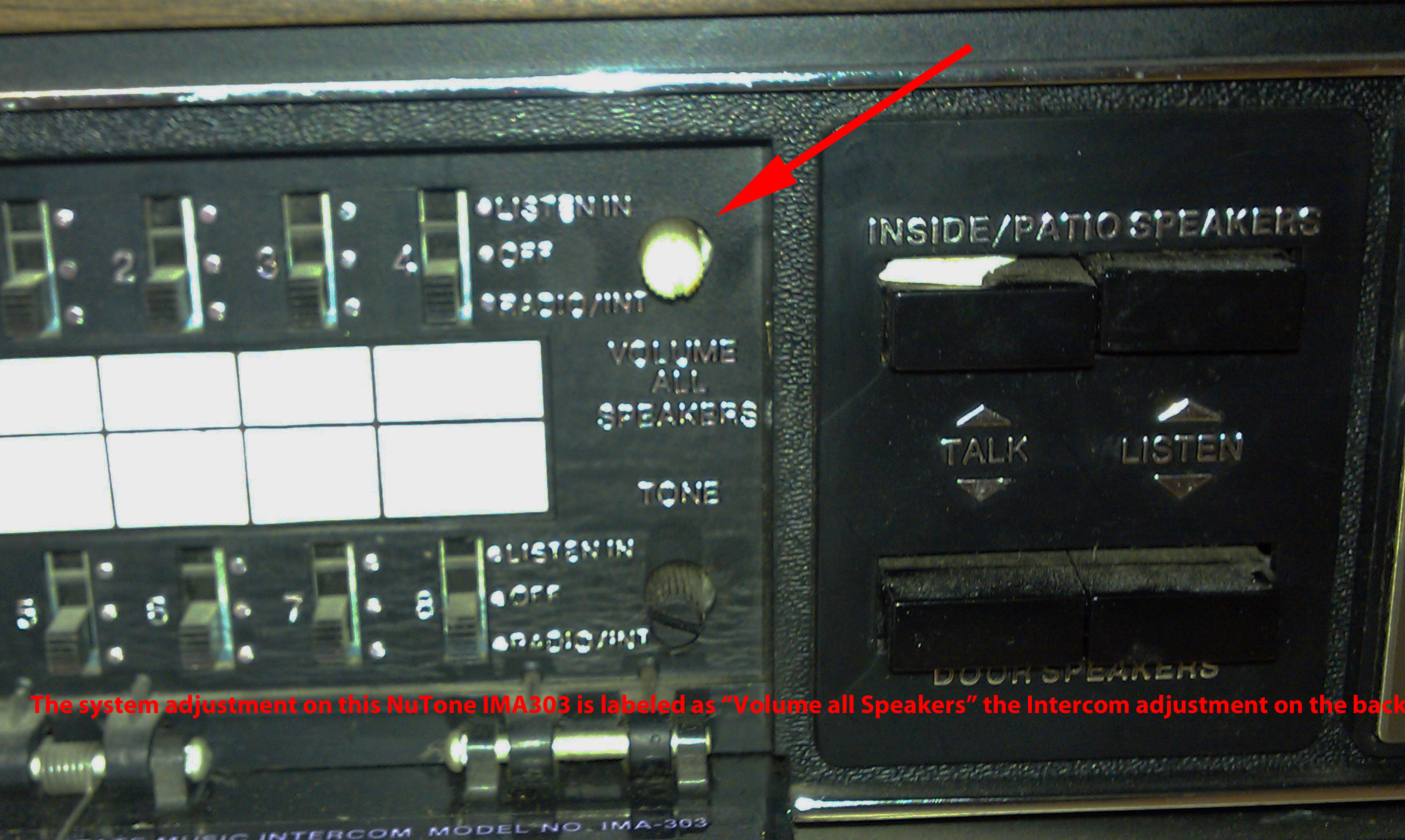
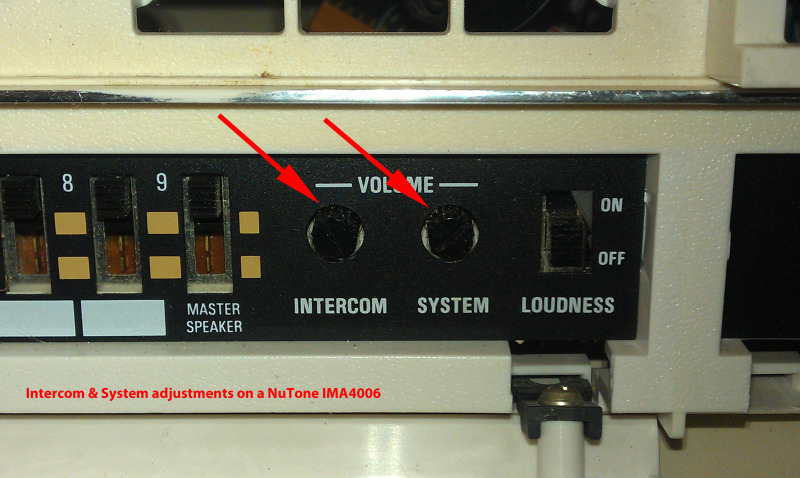
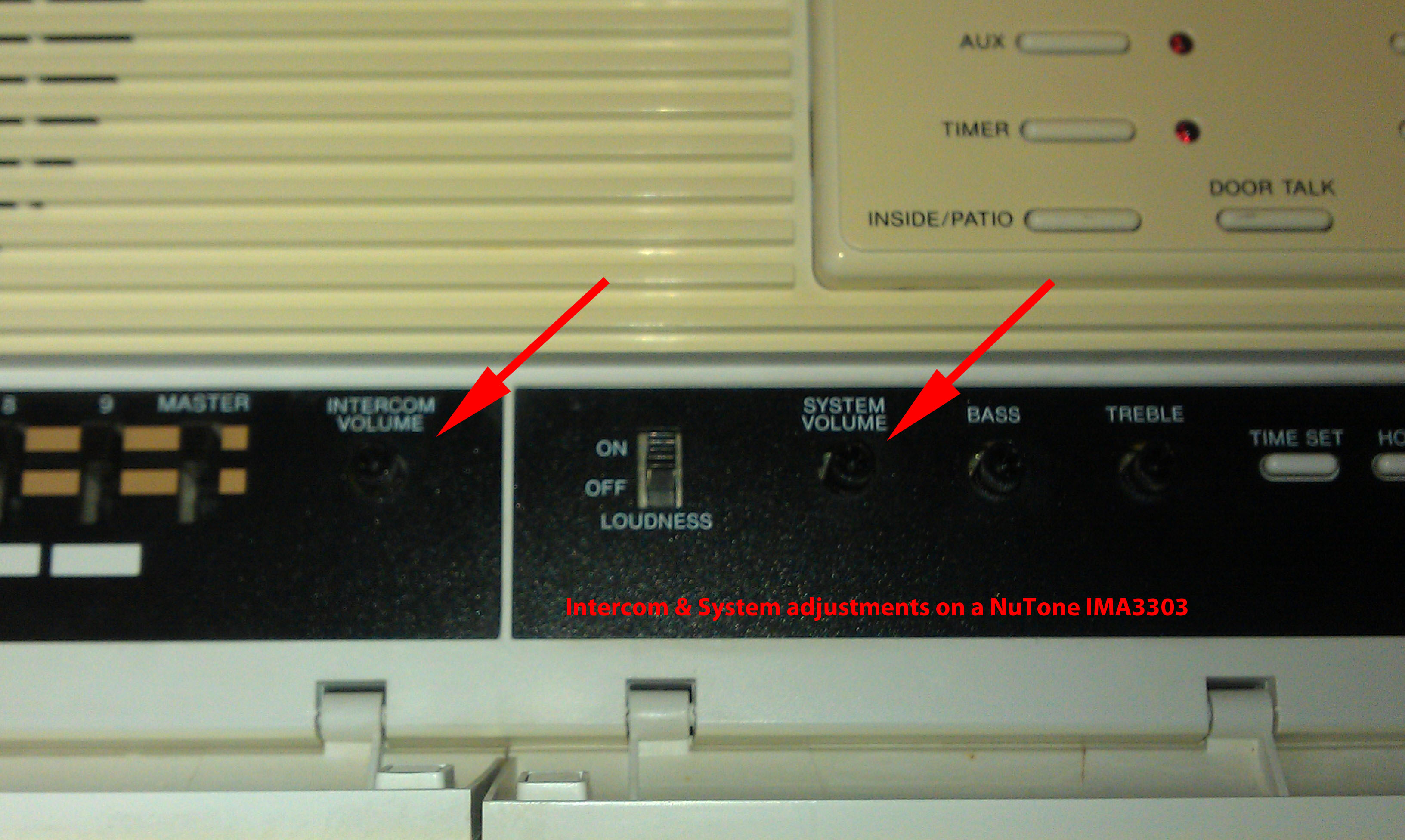
 Cindy & Christopher
Cindy & Christopher
Now that you have your system properly adjusted, let's look at another common problem that will make it seem that your system is broken.
Dirty volume controls on the remote stations will give the impression that you have stations that do not work correctly or at all.
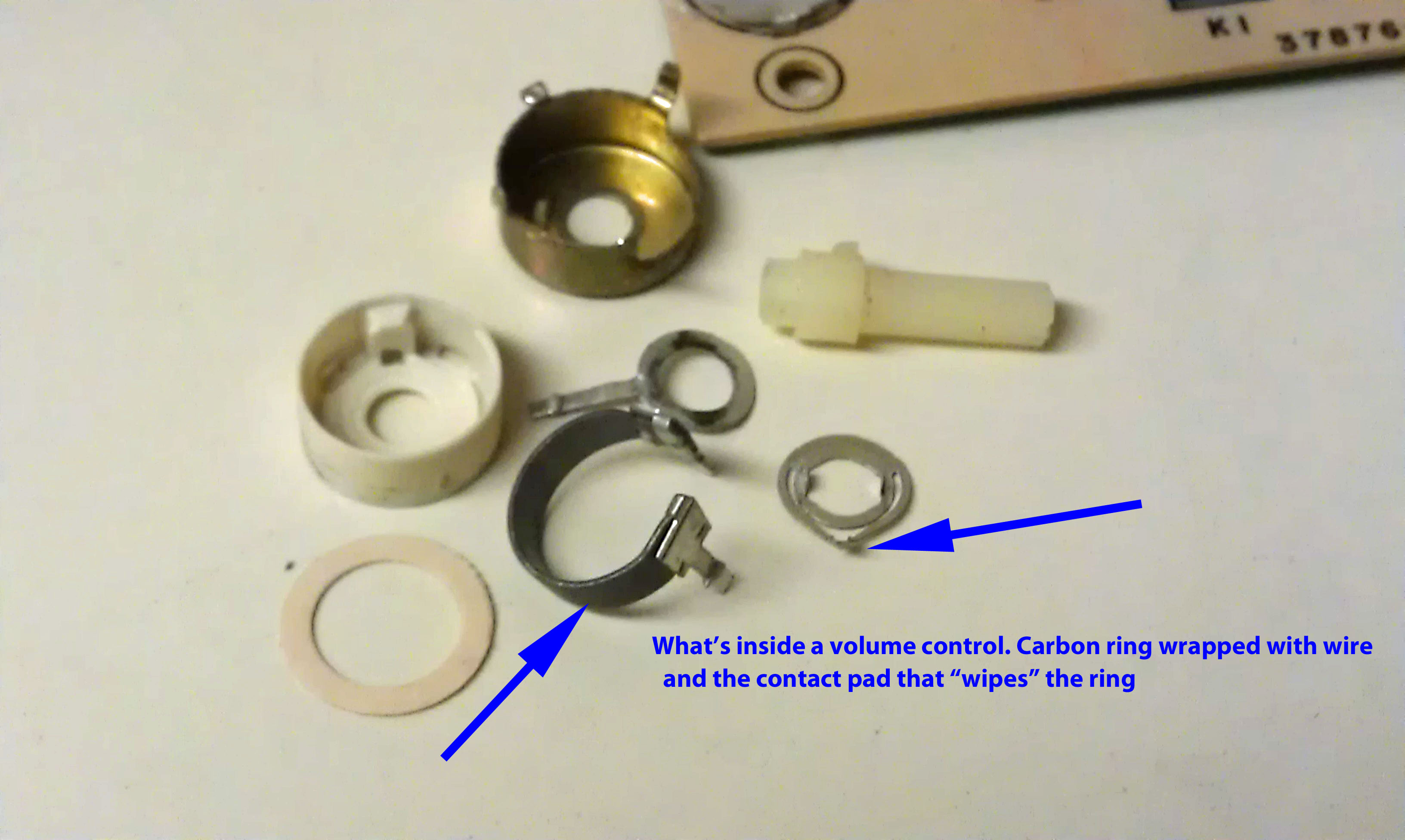
It's important to understand why the volume controls get dirty and how this effects the operation of your system. The volume knob is connected to the volume potentiometer, which is constructed with a ring of carbon (like a donut make from pencil lead) which has a very small wire (the size of a single strand of hair) wrapped around and around the carbon ring. Touching the wire-wrapped carbon ring is a small metal pad which touches the wire and it moves around the ring as you turn the volume knob.
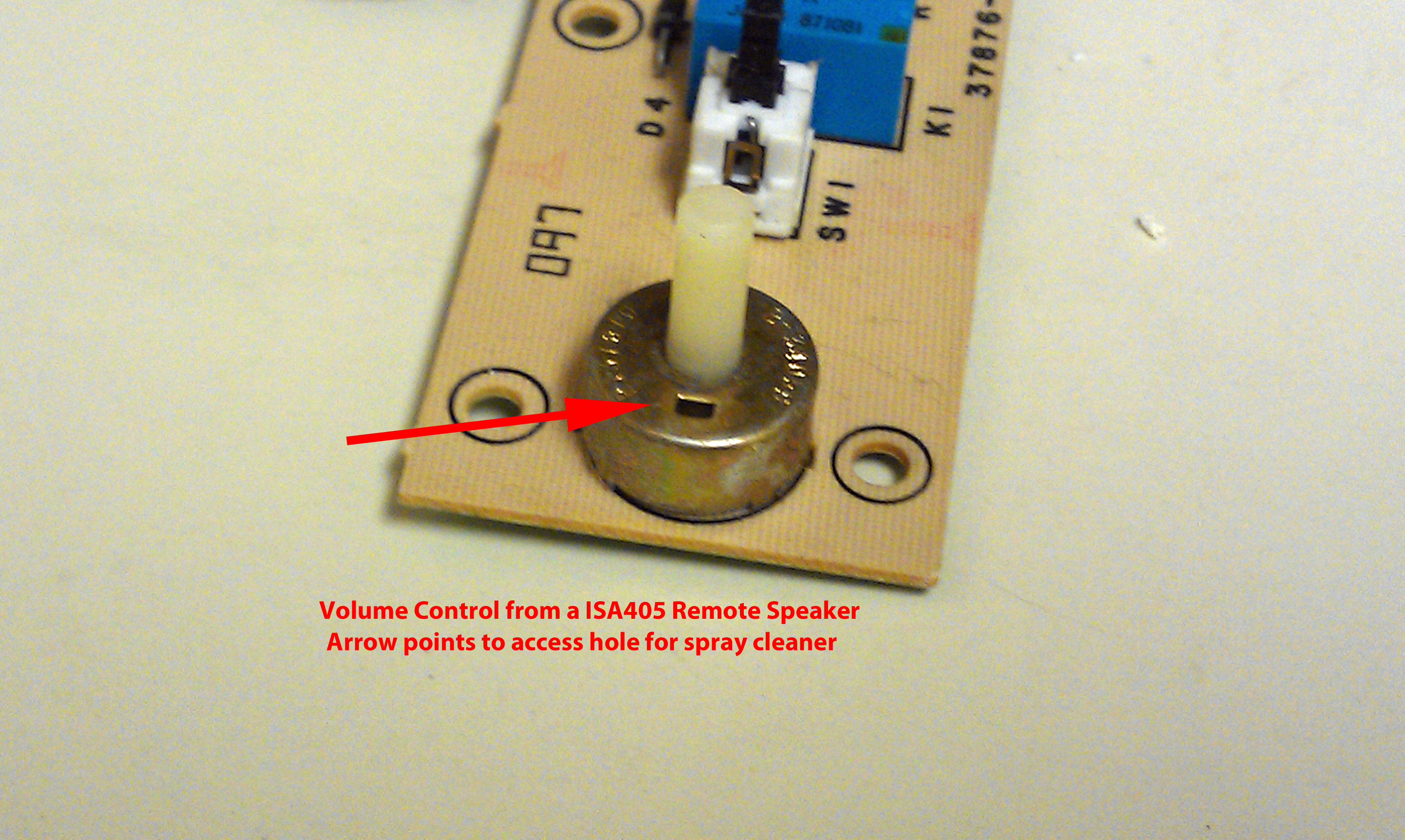
All of this assembly is enclosed inside a metal case, which has holes in it. Over the years, dirt, dust and sheet rock particles filter down the inside of the wall cavity and get into the inside of the volume control.
The dirt and dust builds up a layer over the small wire that wraps the carbon ring. Dirt and dust is an insulator (electricity doesn't go through it). When you turn the volume knob form where it has been set to for the last 12 years, you are moving the metal pad from its clean spot over to a dirty spot.
Since the dirt and dust is an insulator, the pad looses its connection and the sound from the station stops.
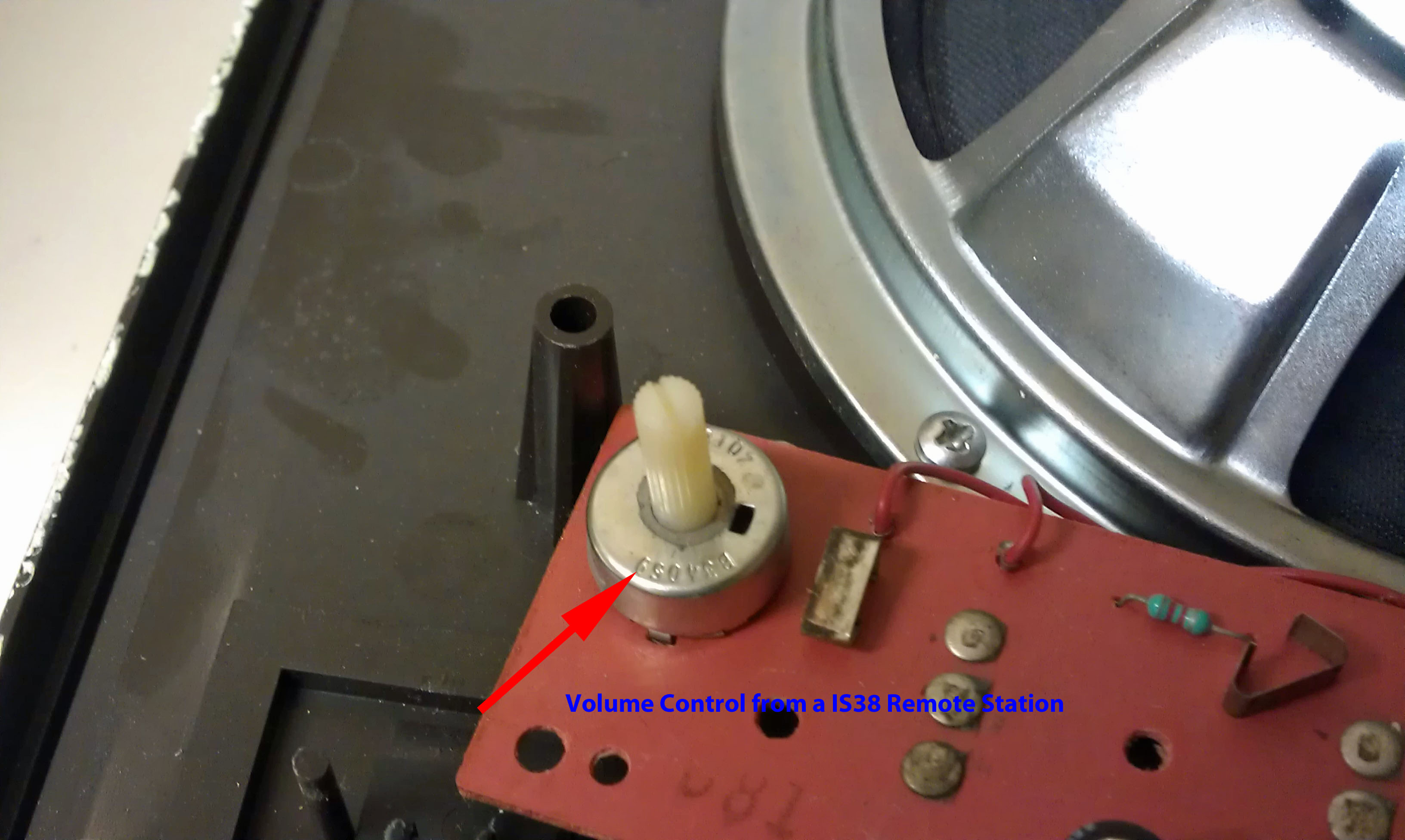
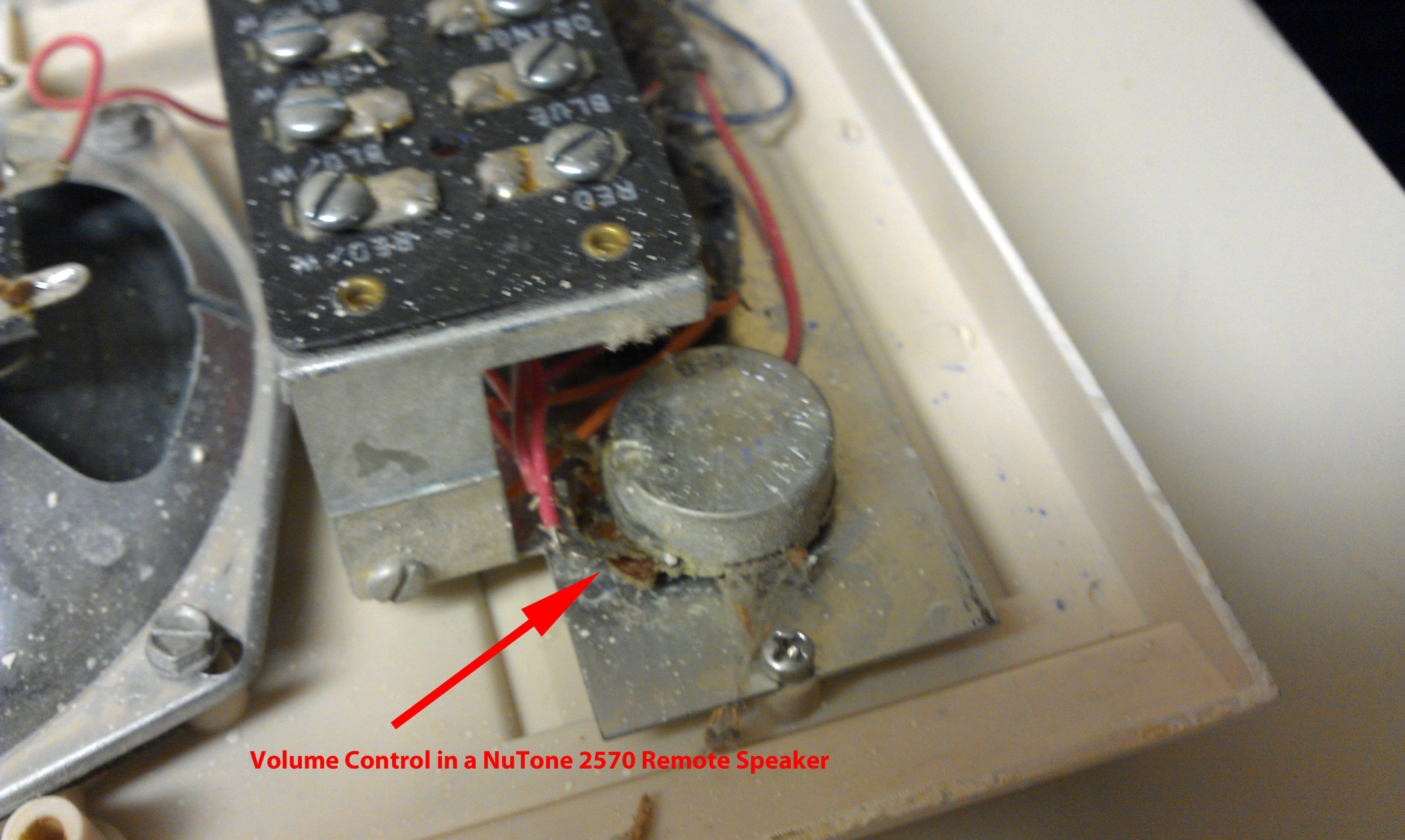
The way NuTone volume controls are designed allows this problem to be corrected by simply turning the volume knob back and forth many times to clean away the dirt and dust. This will solve many intermittent volume related problems.
Sometimes when the volume control is very dirty it will need to be cleaned. You MUST NOT use WD40, carburetor cleaner, TV tuner cleaner, silicon spray or any type of electrical contact cleaner. All of these are the wrong type of cleaners and can shorten the overall life on the volume control or just ruin it. These are all basically solvents which will quickly evaporate and leave the control worse than when you started.

Over the years I have used many different brands of cleaners and I have settled on two products made by the Caig Company. I use DeoxIT D5 to clean the control and I follow it up with DeoxIT Fader F5 to help restore the smoothness of the control.
Cleaning volume controls is a task where less is definitely more. You do not need to “flood” the control with cleaner. The smallest amount sprayed into one of the openings in the case, followed by vigorously turning the volume knob fully back and forth will usually do the job. A second application can always be done if needed.
Why is less more? When the volume control was manufactured it had a small amount of DI-electric jelly (looks like Vaseline) placed inside the control to help prevent corrosion of the small wire-wrapped carbon donut, and to give the control a smooth feel as you turn the knob. Flooding the control with cleaner will wash away the Di-electric and the control will have a rough feel as you turn it and it will corrode more quickly.
After the application of the DeoxIT D5, cleaner a small spray of the Fader F5 will help restore the feel of the control when you turn it. Again, less is more. Just the smallest amount is needed.
This type of cleaning is only typically needed every 8-10 years, more than that has the same effect as using to much cleaner. If you notice that the control becomes a little “scratchy” sounding later on, just turn the control fully back and forth to wipe away the dust and it should be fine.
Now that we have cleaned the volume controls, let's take a look at the intercom control switches on the remote stations.
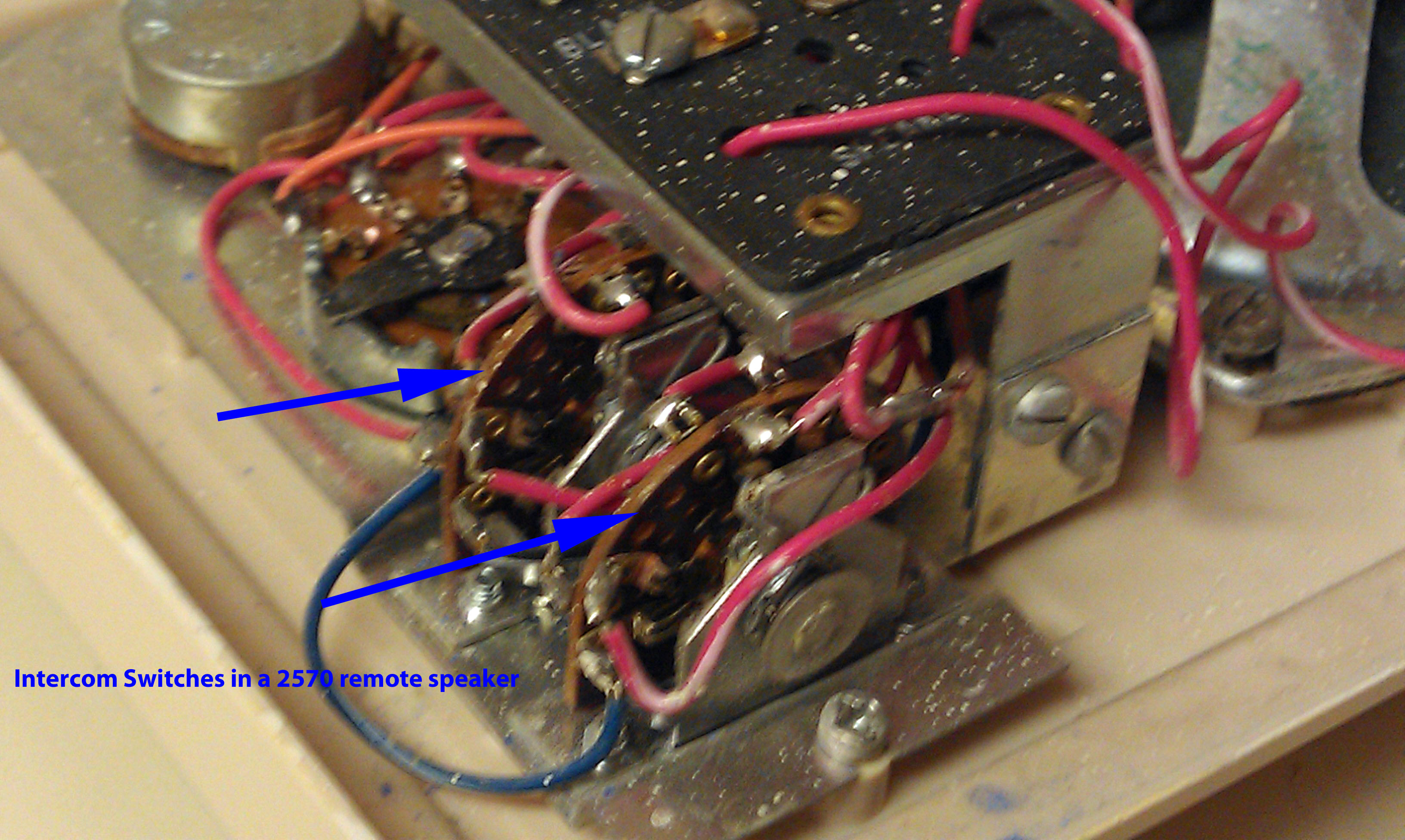
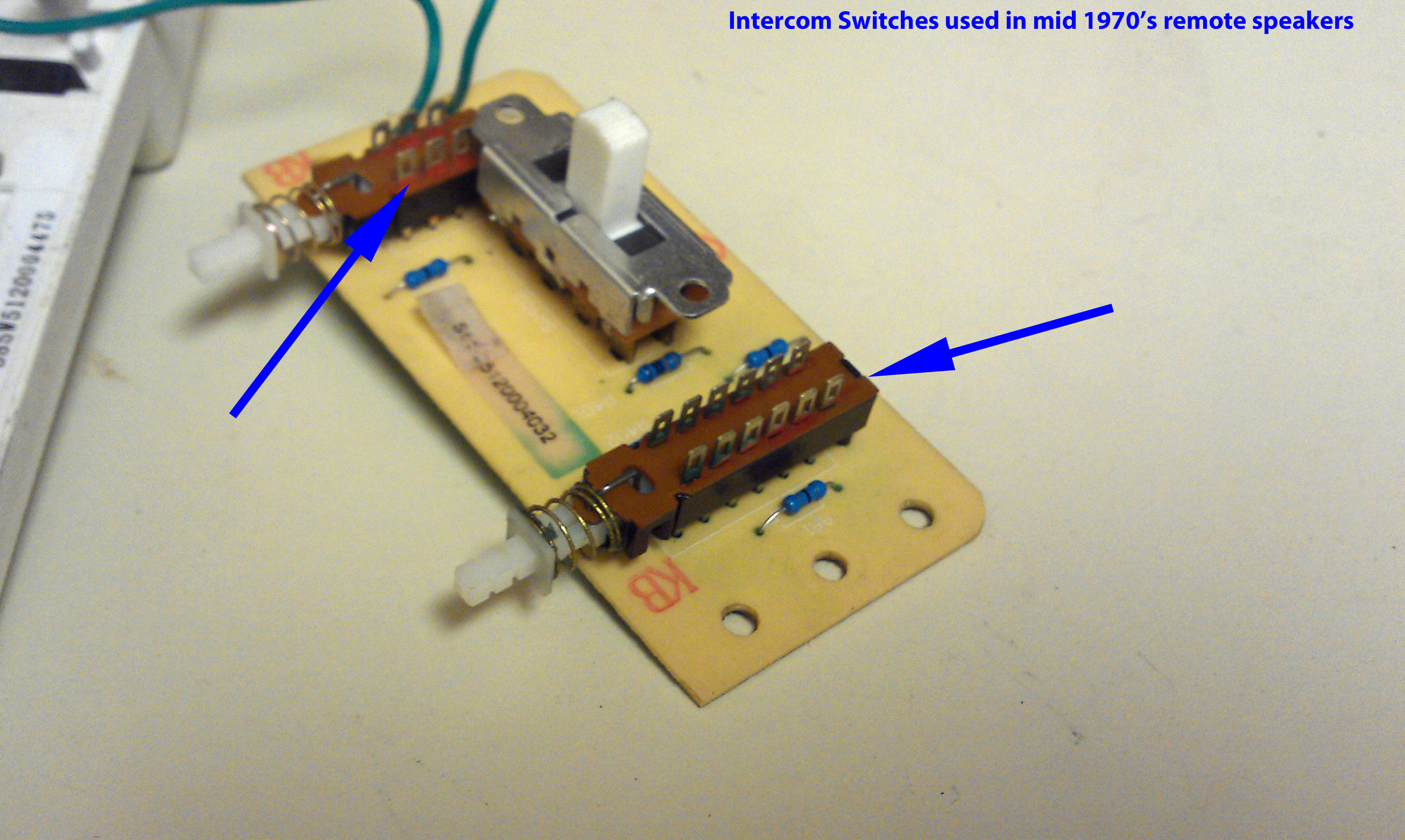
NuTone has used many different types of switches on remote stations over the past 40 years. Even though they differ in design, they all share a common problem. Just like the volume controls, dirt and dust, and especially sheet rock dust, cause many problems with these switches.
The typical symptom of dirty and worn control switches is a loud “scratchy” noise that you hear through the intercom system when a switch is operated.

This noise is caused by the contact surface of the switch being scratched by the dirt and dust that gets inside the switch over the years. When the switch was new, the metal surfaces inside the switch were clean and polished and ultra-smooth. When you operated the switch, the metal surfaces could slide across each other easily and everything was perfect.
Over the years dirt and sheet rock dust get inside the switch and coat the metal surfaces. When you operate the switch, the metal surfaces slide across each other along with the dirt, and the dirt scratches the metal surface.
Now the metal surface is scratched. When the switch is operated, instead of clean, polished surfaces sliding past each other, it's more like rubbing 2 pieces of sand paper together. The surfaces are rough (on a microscopic level) and the “scratchy” noise you hear is the electricity moving across the rough surface.

While there isn't a permanent solution for scratchy switches (short of replacing the switch with a new part) cleaning the switch will help a lot. You can use the same cleaners as the volume controls. Simply spray the switch with just a little D5 and work the switch until it improves. You may need to use several applications because getting the cleaner inside the switch can be more difficult than the volume controls.
I have cleaned systems that were basically unusable due to dirty volume controls and switches and often these system can be restored to 70%-80% of new with some careful cleaning.
Cleaning outdoor Patio stations is the same as cleaning inside stations, except Patio stations are often in much worse condition. Having been outside in the weather takes a real toll on equipment and even the best cleaning job will not always restore a Patio station.
 Cindy & Christopher
Cindy & Christopher
OUTDOOR STATIONS: ENTRY DOOR & PATIO STATIONS
Now that you have your system adjusted correctly, and you have cleaned all of the volume controls and intercom push buttons, it's time to take a look at the condition of your outdoor speakers.
Outdoor NuTone speakers are located at an entry door or on a patio or deck. Entry door speakers will either be just a grill with a speaker located behind the grill, or it may also have a door bell pushbutton on the grill.
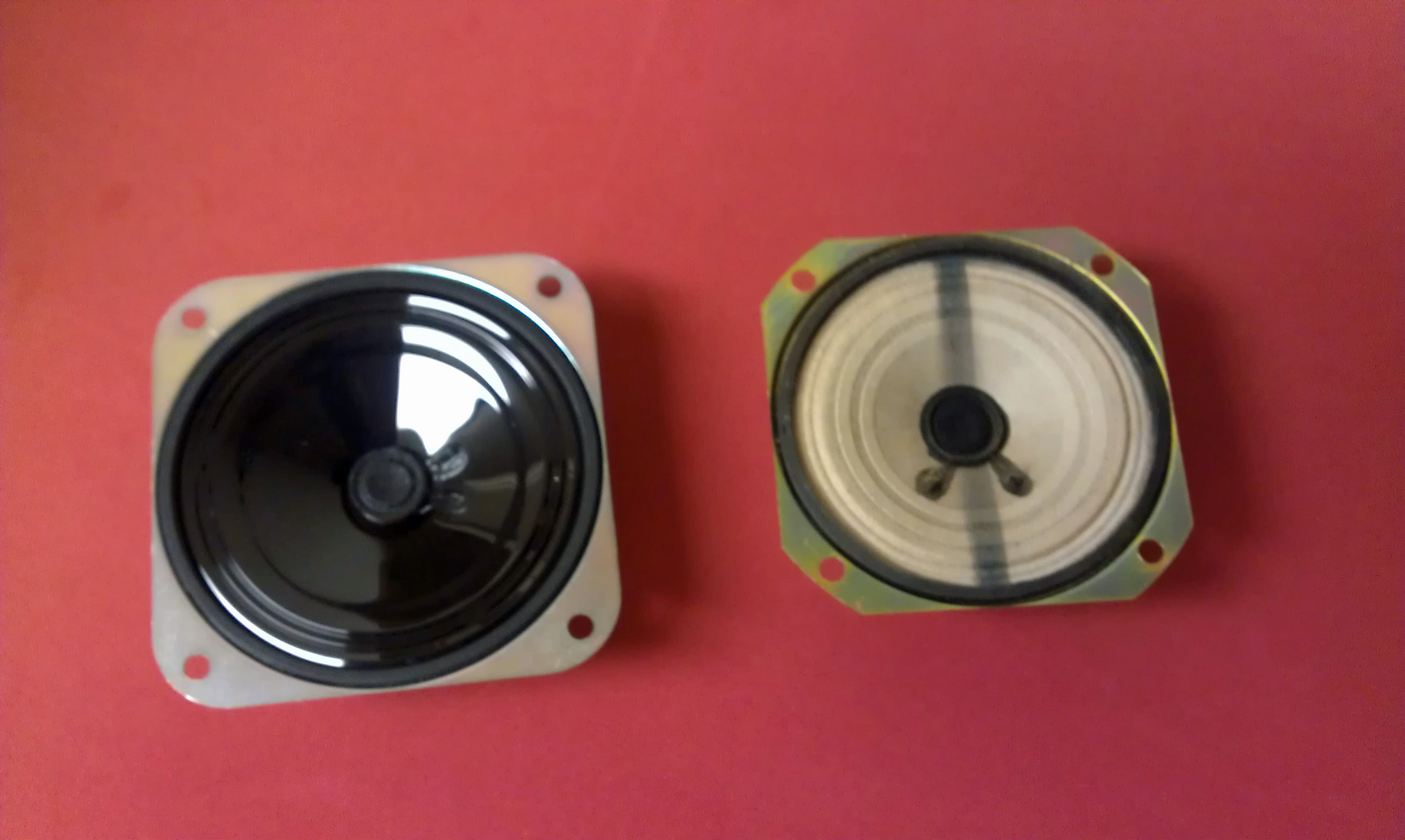
Older NuTone entry door speakers used to have paper speaker cones inside a metal frame. Over the years, the paper would rot away from the sun and rain and sometimes little insects would eat the paper. Starting in the late 1980's, the paper cones were changed to plastic, which improved their longevity.
Even with plastic cones the speaker can still fail. Replacing door speaker cones is easy. They are all 3-1/2” square 16 ohm speakers and are commonly available from any NuTone Service Center. All you have to do is remove the grill from the wall housing, turn it over, remove the 2 wires from the speaker terminals, and remove the 2 or 4 screws that hold the speaker to the back of the grill. Reassemble in reverse order, and you're done.
Patio stations come in several different configurations. The earliest patio stations were all 2 piece designs. On the outside wall there will be a small recessed panel which has both the volume control and intercom pushbuttons on it. Higher up on the same wall will be a large 12” x 12” aluminum grill with a speaker cone behind it.
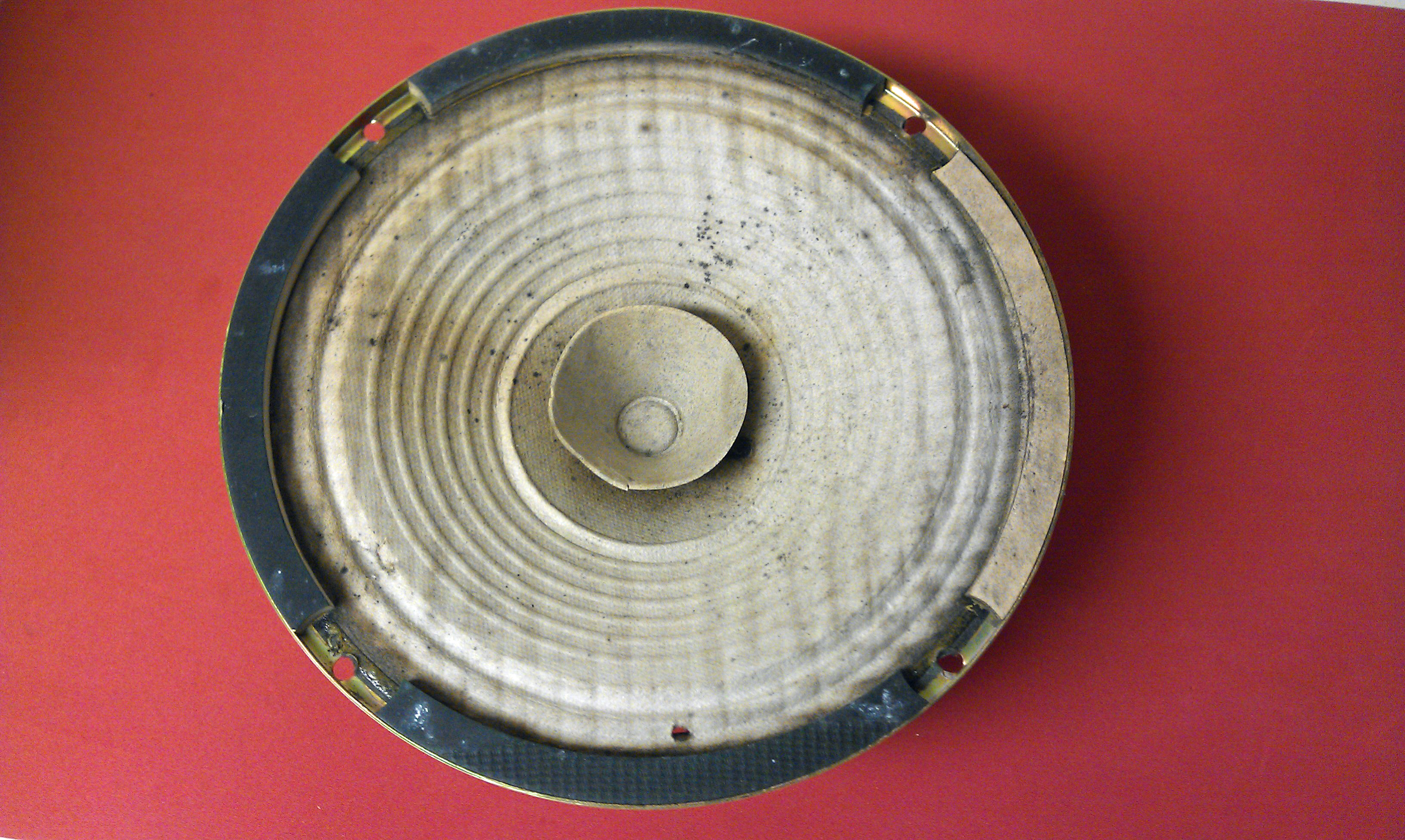
The speaker cone behind the grill will be either a paper-coned speaker or it might be made from a piece of flat Styrofoam. These were call Poly Planar speakers and they last almost forever. All of these cones are 8” diameter.
Starting in the 1970's, a smaller one piece patio station was introduced. It is usually an outdoor version of the same size station from inside the house. These use 5” diameter speaker cones.
Let's look at NuTone speaker cones throughout their history. Speaker cones have a rating in Ohms. This is the impedance of the speaker and it is important. The original NuTone speakers cones were 3.2 ohms, then systems changed and used 45 ohm speakers, then systems changed again and speakers became 25 ohms. You may notice that none of these ratings are 4 or 8 ohms, which are used in home stereo systems.
It is important to have the correct impedance speaker for your system. If you use the wrong speaker it can make you system operate incorrectly, or even cause the master station amplifier to fail.
Replacing speaker cones is easy and will restore your system to full operation. If you have a multi-meter, you can check the impedance of the speaker cone by first removing the wires that are connected to the speaker, and then connect the meter to the terminals. The reading should match the rating stamped on the speaker magnet. If you get a reading of 0 or infinity, the speaker cone has failed.
 Use this Button to find out about Replacement Patio Speaker Cones
Use this Button to find out about Replacement Patio Speaker Cones
Basic Troubleshooting & Wire Types
A common problem with many NuTone intercom systems is that 1 or 2 of the stations on a system will not work correctly. Maybe the volume is low or the intercom functions don't work properly. This may be a problem with the station itself or it can be a problem with the wiring.
A simple way to determine what is causing the problem is to swap the troublesome station with another station in the house that works correctly. If the problem follows the suspect speaker, then the speaker is the problem. If the problem remains in the original location, the it might be a wiring problem.
When swapping speakers around, you must take notice of how the wiring is connected. You may have 3, 4, 5, 6 or 8 wires connected to the back of the speaker. NuTone Intercom systems were designed to be easy to install, even by the do-it-your-selfer. All of the wire connections will be labeled either by the color of the wire, or in the case of 3-wire systems, by the actual metal inside the insulation.
On 3-wire systems, the cable is a flat, gray 3-conductor ribbon wire. Inside the insulation you will find that the wires themselves are different colors. #1 is silver (this is used to index the side of the wire you start from), #3 is copper, and that only leaves the center wire (which is also copper, but it's in the center of the cable).
If you look at the back of any early 3-wire station, you will find molded into the plastic “Silver”, “Center”, “Copper” and arrows that point to the screws where the wires connect.

Later, NuTone added a red stripe to wire #1 (silver) and a blue stripe to wire #3 (copper) to make it easier. You will find stations labeled as “red/silver”, “Center” and “Blue/Copper” on stations from then on.

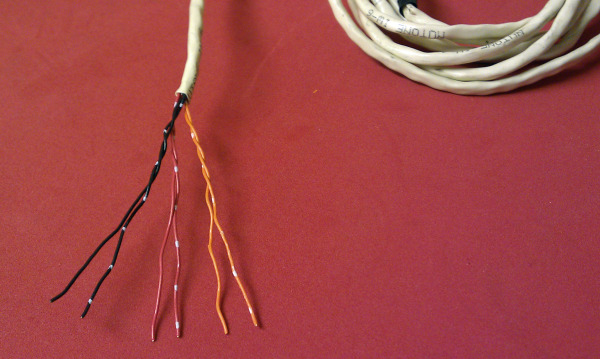
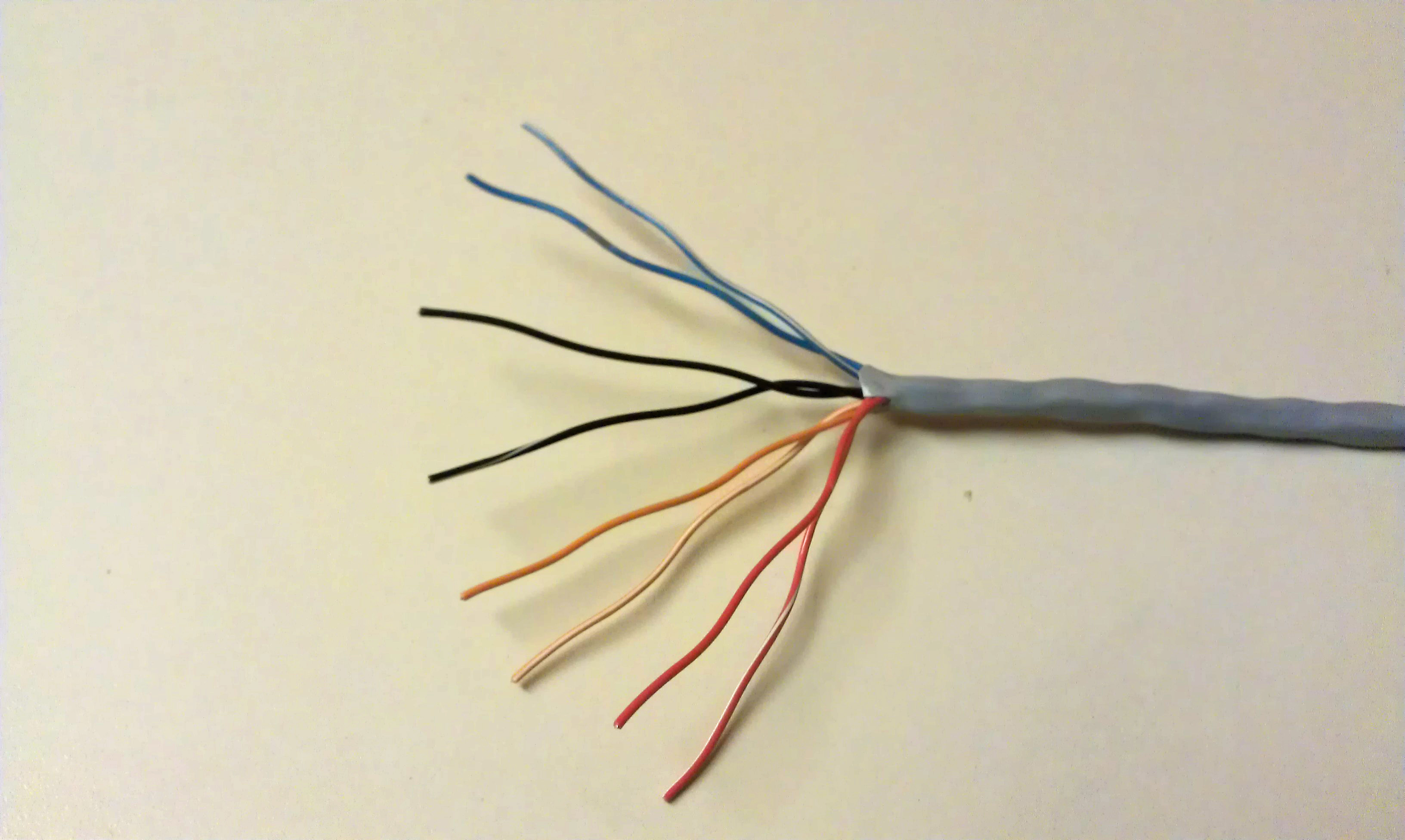
On 6 and 8-wire systems, you will have 3 or 4 twisted-pairs of wires. These twisted-pairs will be colored Red – Black – Orange – Blue (blue is only in 8-wire cable). If you look at the pairs carefully, you will see that in each pair, 1 wire will be a solid color and the other will have a white stripe. This is how the wire is indexed for proper polarity.
When you look at the connections on the back of a 6 or 8 wire speaker station, you will see that the screw terminals are labeled “Red/Red White”, “Black/Black White” and so forth.
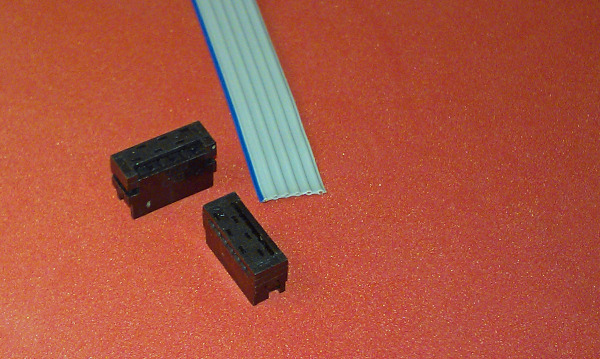
The exception to this is a special type of wire that NuTone used from 1986 through 1992. It is a special type of 6-wire cable designated IW6R. IW6R is a flat 6-conductor ribbon cable used on the original IM4006 system.
The idea behind this ribbon cable was the it used special crimp-on connectors which terminated the cable and plugged on to the matching connector on the speaker board.
This design was a great failure. The original IW6R ribbon wire had solid wire in the cable and it often failed to make a proper connection in the crimp-on connector. Later the wire in the cable was changed to stranded wire, which helped the termination problem to some degree but it did not solve the problem completely. The primary issue, after the wire design was resolved was that installer would not read the instructions on how to terminate the wire, and if it was done incorrectly, the connection would not hold up.
I must have completed hundreds and hundreds of warranty calls which just involved changing out all of the crimp-on connectors.
IW6R cable has a blue stripe on one edge, as an index to identify the wire strands inside the ribbon. Starting on the edge with the blue stripe the color order is: “Red/White”, “Red”, “Orange/White”, “Black/White”, “Black” and “Orange”.
It is important to keep this order consistent throughout any installation when you are reusing IW6R cable and installing new equipment.
Reader Comments (105)
I could not find the e-mail link on your website. I have an IM-860M intercom system which was purchased new during the 1980's but never installed. I know someone who has a model 3003 which no longer works. There are burnt areas on one of the circuit boards. I would like to replace their system with my 806. Is that feasible?
Unfortunately an IMA806 will not be the correct replacement for an IM3003, because the IMA806 is a 6-wire system and the IM3003 is a 3-wire system. The IM3003 is probably repairable and you can contact u s by email for information about having it repaired.
Hello there. We have lived in our house for over 12 years now, and when we moved in there was a radio/intercom system, which is a NuTone IMA-203 FM-AM. We are in the process of remodeling our kitchen, and we would like to replace the radio chassis so it will not look so outdated. The system works okay.. I was reading your article and we are having some of those problems, but we only use the radio, not the intercom. We can take the steps to clean off the controls inside it, and it will most likely work perfectly. Anyway, is there any way to just replace the radio in our kitchen and not have to replace the whole system? All the newer systems seem to be so much smaller than ours, and the hole in our wall is pretty big (about 16 x 9), so not sure if this will work. What do you suggest?
Thank you,
Joni L.
Hi Joni,
Unfortunately you will not be able to replace just your IMA203 Master Station and reuse the remote stations. This is because of the age of your system and that it uses a different design platform than the new NM100 series. It will be necessary to replace not only the IMA203 but all of the remote station as well. All of the new NM series equipment is smaller than your equipment tha is installed in your home, however NuTone does offer a wide variety of update frames that will cover the existing opening behind each station.
If you would like to contact me directly, I will be happy to help you put together a proper list of the new equipment you will need to update your IMA203 system.
Chris
I got a call from a colleague who has a 3303 system, already upgraded once from a 3003 (?). He's complaining his door chime (unknown model) doesn't work, and "the repair guy" said a) he needs a new one, but b) they're not available, but c) he can get something for $180 which "might" fix the problem. I ran the computer department before retiring, so that makes me the expert on all things electronic. I'm going over there tomorrow to have a look, and your site has been of great help in getting me going. That's all I know now. Any tips would be appreciated; for now I'm just going to do some basic debugging, wire tracing, checking for obvious damage, proper power, etc. I may be in touch to see if I should just put all the pieces in a box and send them off to you.
Hi Mike
There's not enough specific information for me to give you any solid ideas or answers as to what or where the problem is, however if the original Chime Module was reused from the original IM3003 in the new IM3303, it would not be uncommon for it to fail after having been transfered. I have seen this happen many times.
Problem solved without even going inside. I don't know what "the repair guy" had for qualifications, but I'm a believer in KISS. Took the cover plate off the unit by the front door, and shorted out the terminals on the pushbutton. Bing, bong, etc. Replaced the pushbutton with a generic lighted button switch from Home Depot (gen-u-ine Nutone buttons are available for $7 online) and he was good to go. Old switch was apparently corroded after 20 years in the Florida outdoors, which isn't a bad record. Owner was so happy to have saved $178 that he let me hook up his new DVD/VHS recorder to his giant LED TV.
Hello we have a 3303 system installed in our house and it worked like a champ until an electrician did some work for which he had to turn a bunch of breakers on and off at the main switch. Since then the Nutone master station is stuck on the one FM station it was on previosly and it ignores all buttons, swiches etc. Cannot change stations, cannot turn it off nothing. Luckily, I was able to turn the volume down all the way so it is at least quiet. Any ideas where to start? Any help would be appreciated. The wife is on my case to fix it ASAP. Help!
Hi, Your IM3303 needs to be reset. Open the right hand door on the bottom edge of the master station, the last button on the right is the "memory set" button. Just past the button is a hole in the panel, inside the hole is the main reset button. Use a smaller screwdriver or toothpick and push the reset button, hold it for 5 seconds. This should correct the problem. If not please call me to discuss further troubleshooting.
Chris
Chris,
Thanks for the prompt response. I tried the reset procedure and the results are below:
1) Before reset: LCD Display blinking & FM Red LED solid ON
2) During reset (button in depessed state): LCD display blank & FM Red LED OFF
3) After reset (button released): LCD display back to blink & Red LED solid ON
In other words, the reset procedure didn't seem to make any difference (unfortunately). What should I do next?
Hi IB,
Please fill out an Intercom repair Request Form (last link in the Navigation section) and once I have received it, I will contact you regarding the problems with your IM3303
Thanks
Chris
Hello,
I have a Nutone Model 2055/2056. The tubes are good. When I turn it on there is a loud hum. The hum is equal no matter if you turn it to AM, FM or the turn table. Eventually it gets low enough you can hear the FM/AM; however, it never entirely disappears. I went to an electonics store and he suggested replacing the "can" of three capacitors might fix it. I don't mind taking a shot at replacing some of the capacitors, but wondered based on your experience which is the most likely failing part? Thanks. My email is thewatson@hotmail.com Dave
Hi David,
The hum you are hearing is likely caused by failing 50 year old capacitors. It would be best to replace all of the capacitors in the 2055/56 while you have it apart. The 3-section can capacitor will be a challenge because it is no longer available and finding a match for it (size and values) is unlikely.
When I have these early models in for repair, I "restuff" the can capacitors with modern capacitors to preserve the original look of the unit.
I will also caution you that tube based models have HIGH VOLTAGE and HIGHER VOLTAGE in them to drive the tubes. Extreme caution needs to be taken when working on tube equipment, other wise you can be hurt or if the repair is done incorrectly, it can become a fire hazard.
Thanks
Chris
Thanks Chris,
I would be willing to try it. However, if you still do these repairs, could send me a price to do that work? If not, how do you take the can apart without destroying it? Why did they put them in a can anyway? Was it because of the higher voltage?
Thanks,
David S.
Hi David
Multi-section capacitors were used mostly because they were faster to install during manufacturing. These type of components date back to the early days of radio in the 1930's. I do rebuilt the older tube based models that NuTone made, in fact I have a model 2057 / 2058 Master Station in the shop right now for a rebuild. Please fill out an Intercom Repair Request Form (under the Navigation Heading) and once I have received it, I will contact you about the information you provided.
I have a 3003 system in a home built in 1986. It has power (I can see the clock and radio station on the digital readout) and when I push the talk buttons I can here static/popping on the local unit
(same goes for pushing buttons on the remote units, just static momentarily when the the button is pushed). The doorbell doesn't work and you can't hear anyone talking between units. None of them.
I opened the main unit and sprayed with compressed air and vacuumed debris (it was full of drywall dust and spiderwebs). I momentarily heard a radio station on the remote units but then it stopped and I couldn't get it back.
What would be the first thing you would try in this situation? Cleaning volume nobs? Thanks for a great site btw!
Hi M,
Yes, I would clean all of the volume controls and push button switches first to see if you can get the radio to play throughout the home. You can buy some Deoxit Cleaner from Radio Shack.
Chris
Chris,
My son just bought a 1972 home yesterday with a model 203 Music Sound, serial # k838155a, in the wall and seven wall intercoms. Is this a New Tone unit? Nothing works as the main unit was no longer wired up to anything, including to the 120v source. The home run wiring is in tact with 4 pair wires. The main intercom/radio also appears in tact. I would like to get it working again. Your suggestions. I am willing to send the main unit to you and have it gone through. It is very dusty and if you can get it working I would like a new cover. Ron
Hi Ron,
From your description I think you have a Music & Sound brand Model 203. If you contact me diorectly I can refer you to someone I know that rebuilds M&S equipment.
Thanks
Chris
Thank you for your clarity. It helps a lot.
I get freq calls on intercom repairs in los angeles
Do you also repair tektone amps
Hi Jack,
Thanks for the comment. I don't work on Tektone equipment equipment.
Hello, I have the model 2057-2058 and it seems to work just fine. I turn it on and theres power, lights come on but the intercom doesn't work and neither does the radio. I was maybe thinking the tubes are whats wrong with it?
Hi Robert,
While there may be some tubes that need to be replaced, it's likely that there are other things wrong as well. Your 2057 is around 50 years old and time takes its toll on all sorts of parts and assemblies. The last 2057 I rebuilt (just a few weeks ago) needed 8 replacement tubes, new capacitors (including restuffing the multi-section can) and lots of solder re-flowing to bring it back to life. After a little tuner adjustment it played very nicely and work correctly. Please note that tube based models have HIGH-VOLTAGE in their chassis's, which CAN HURT YOU A LOT if you don't know what your doing!!!!!!!!!!
If your interested in have your 2057 / 2058 rebuilt, please fill out an Intercom Repair Request Form and I'll contact you about your Master Station
Thanks
Chris
Hi Cindy & Christopher,
My house has a Nutone 3103 installed. The system has 4 indoor units, 1 outdoor unit, 2 door units, and the master unit. The intercom feature can be used between the bedrooms and main unit, with lots of terrible cracking noise when switches are pushed, but then the voice is loud and clear. I will have to clean those switches as I read. I can answer the front door (I replaced this unit with an original ISB-64 I bought online, I have not been able to find a second unit to replace the one in the back door that doesn't work. I replaced the unit, however the push bottom does not make the doorbell to go off at the master unit or speakers. I have a regular doorbell, so I know when someone is at the door. Sometimes at any time but I think when it gets cold, or in the middle of the night something triggers the chime to go off continuously, and I can hear the chime in all the units. There is no way to stop it, I usually go to the master unit and turn the volume down and turn all the speakers off. Sometimes the chime stops by itself.
Another issue is that the radio does not have enough volume, I can barely hear the radio if I put my ear next to the speaker, even in a loud volume setting. The patio unit does not work, even the knob or switches won't move, too much humidity in Texas (or I think they installed an indoor unit in an outdoor location. The answering machine does not work. I'm not interested in having it working since I recently cancelled my landline.
What are my options? Is this repairable or should I replace the system?
Thanks in advance for your time.
Perry
Hi Perry,
Your IM3103 is a variation of the basic Model IM3003. The difference is the addition of the Cassette Tape Answering Machine which also doubles as a cassette player throughout the system.
Your IM3103 has the same basic problems that a IM3003 will have, dirty volume controls and push buttons in the remote stations, which all can be cleaned as outlined on this site.
The ISB64 Surfaced Mounted Entry Door Speaker on your back entry probably has a failed speaker cone which is still available and is easy to replace. You can contact us for a replacement cone if needed.
I am unclear about the problem with the door chime, I am not sure if you have a built-in Chime Module installed in the IM3103 or if you have a separate wall mounted NuTone Electronic Musical Chime that rings in it's location and is connected to ring through the IM3103.
If you have the separate wall mounted electronic chime (which I think you do, perhaps a LB55) the problem with the chime not ringing when someone pushes the button and then at other times it rings continuously and won't stop could be a damaged wire or an aged related problem with the chime itself.
If you have a Chime Module installed in the IM3103, all of the problems are likely to be Chime module related.
Non working Patio Stations have usually just weather away and they can be rebuilt (new speaker cone and switch board) or just replaced with a good used station.
The Answering Machine in a IM3103 was a very tricky design and for the most part is very outdated and not compatible with many modern phone systems. For some homeowners have the ability to play cassette tapes makes the unit useful, although adding a MP3 player input jack makes more sense than trying to repair the answering machine section of a IM3103 just to play tapes.
Finally, the lack of overall system volume is caused by a failed Power Supply - Amplifier in the IM3103, this is the same type of problem that all IM3003 will have. This is a common and easily repaired problem.
The choice to repair or replace is always the customers choice and I get asked this a lot. Based on the number of Intercoms we repair every year, and all of the owners I speak with, repairing the Master Seems to be most peoples choice.
If you are interested in have your IM3103 repaired, please fill out an Intercom Repair Request Form (under the Navigation Heading) and once I receive it, I'll contact you directly about the repair of your master
Thanks
Chris